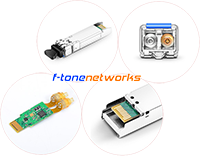- Contact Us:
-
+86-028-85255257
- sales@f-tone.com
标准光模块
标准协议光模块
- 全国产化光模块
- 25G~400G高速光模块
- 200km超长距光模块
- 5G移动通信光模块
- SFP光模块
- CWDM SFP
- DWDM SFP
- BIDI-SFP
- SGMII SFP
- HDMI
- Video SFP光模块
- Copper SFP
- 低功耗SFP
- SFP+光模块
- CWDM SFP+
- DWDM SFP+
- BIDI SFP+
- Tunable SFP+
- QSFP光模块
- QSFP+ 光模块
- QSFP28光模块
- QSFP-DD光模块
- MicroQSFP光模块
- OSFP 400Gbps
- XFP光模块
- CWDM XFP
- DWDM XFP
- BIDI XFP
- 1x9光模块
- CSFP光模块
- CSFP+10G光模块
- 16GFC SFP+
- 25GE SFP+
- 32GFC SFP+
- CXP光模块
- CFP光模块
- CFP2光模块
- CFP4光模块
- CFP8 400Gbps
- CDFP 400Gbps
- DSFP光模块
- FT-61光模块
- OLT光模块
- ONU光模块
- PLCC光模块
- RJ光模块
- SFF光模块
- SFP-DD光模块
- SFP28光模块
- SNAP12光模块
- USOT光模块
- X2光模块
- Xenpak光模块
- 光电编码器模块
- 光模块测试板
- 光模块笼子座子
- DAC 高速线缆
- 光纤滑环|光电滑环
- 光缆车
- 军品级DIN光模块
- 塑料光纤模块
- 替换安华高工业电力光模块
- 兼容国产化替换安华高光耦
- 射频光模块
- 微型多路光模块
- 特种光模块
- 特种光纤连接器
- 特种光电连接器
- USB光纤延长线
- 特种电连接器
- 特种光纤光缆
- 光藕
- SMA测试线缆
- OSA
- PON BOSA
- Pigtailed PD
- RFoG BOSA
- TO-CAN
- 光纤温度传感器
- 光纤应变传感器
- 光纤加速度传感器
- 光线压力传感器
- 光纤位移传感器
- 光纤应力传感器
- 光纤传感分析仪
- 光纤分布式测温主机
- 光纤布里渊信号解调仪
- 分布式光纤声振信号解调仪
- Camera Link
兼容协议光模块
- 华为光模块
- 思科光模块
- 华三光模块
- 中航光电光模块
- 中兴光模块
- 锐捷光模块
- 惠普光模块
- 神州数码光模块
- Juniper光模块
- Extreme光模块
- Brocade光模块
- D-Link光模块
- 赫思曼光模块
- 阿尔卡特朗讯光模块
- Allied Telesis光模块
- Foundry光模块
- Force10光模块
- Blade光模块
- Linksys光模块
- Marconi光模块
- 博达光模块
- 网件光模块
- Nortel光模块
- Moxa光模块
- 海康威视HIKVISION光模块
- McAfee光模块
- SMC智邦光模块
- 安华高Avago光模块
- 飞通光模块
- Finisar光模块
- yellobrik SDI光模块
- 罗克韦尔AB光模块
- 罗杰康光模块
- 研华Advantech光模块
其它种类光器件
- 全国产化光器件
- 光纤阵列系列
- 高速模块微连接
- 相干通讯光连接
- 硅光子器件光链接
- Bio-Medical Equipment
- Components for Fiber Laser
- Components for Fiber sensing
- Components for Optical Network
- EDFA光纤放大器
- 光纤传感器
- High power Component
- Hybrid for EDFA
- Test Equipment & Others
- Test Equipment & Others
- 保偏光器件
- 光分路器
- 光开关
- 探测器
- 光功率计
- 全光纤相位拉伸器
- 光纤准直器
- 光衰减器系列
- 光偏振控制器
- 光源
- 光环行器Circulator
- 光纤延迟线
- 色散补偿模块
- 光纤放大器
- 无源传输转换器
- 光纤激光器
- 光调制器
- 光电探测器
- 光纤偏振
- 光纤滤波器
- 同轴激光器
- 同轴电缆
- 光纤法兰适配器
- 光纤跳线&尾纤
- SMA-特殊纤芯系列
- 特殊接头系列
- 铠装系列
- 光耦合器Coupler
- 皮纤跳线系列
- 大芯数系列
- 回路跳线系列
- 保偏光纤系列
- 光通信组件
- 光隔离器isolator
- 其它光器件
- 可调滤波器
- 可调衰减器
- 拉锥耦合器
- 无源光器件
- 法拉第旋转镜
- 波分复用器
- 滤波器
- 蝶形激光器
- 光耦合器&分路器
- 光纤环形器&法拉第旋转镜
- 光纤隔离器&波分复用器
- 光纤分束器&合束器(PBS/PBC)
- 光纤光栅
- 高速线缆
技术支持
MicroQSFP光模块
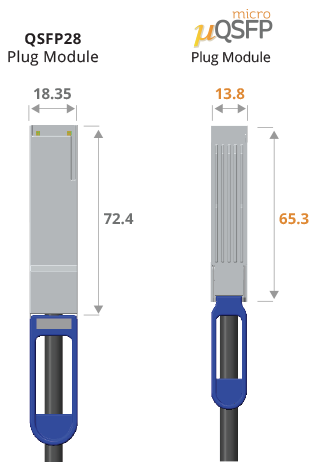
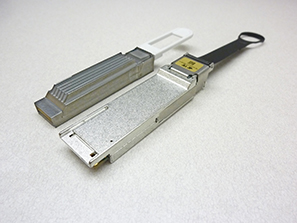
QSFP28 (foreground) and microQSFP plug modules

QSFP28 (foreground) and microQSFP plug modules

Features:
- 33% increase in density over QSFP (based on 48 microQSFP ports vs. 36 QSFP ports in 365mm)
- Same 4 channel electrical interface as QSFP
- Same 3.5+W power capability as QSFP+
- Will support 25G and 50G (PAM4) electrical data rates
Benefits:
- Functionality of QSFP in SFP density
- Significantly improved thermal management
- Accommodates multiple electrical interface generations (4 channels, to 2 channels, to 1 channel), while supporting a long life optical interface WITHOUT changing form factor
- Enables up to 72 ports per 1RU line card
Summary:
- Enables a second generation line card with higher port density than a QSFP based line card
- Enables the same IO density as SFP with improved thermal management and increased bandwidth density
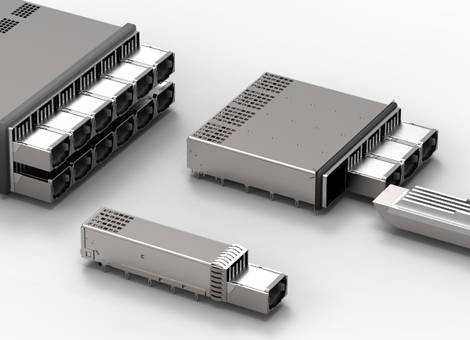
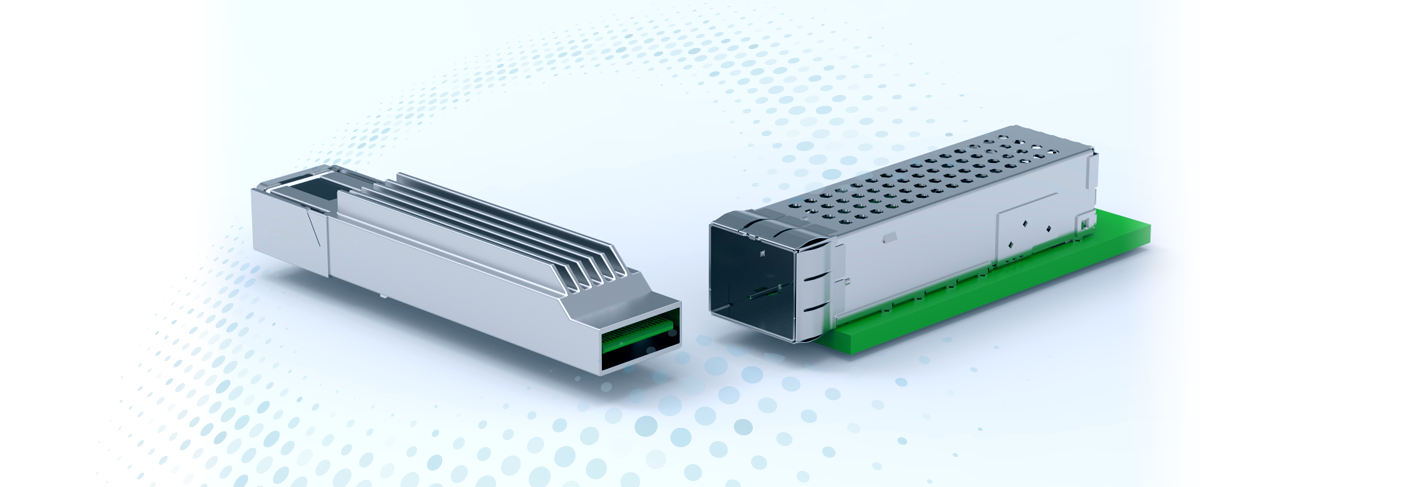
Then members of the μQSFP MSA supporters:F-tone Networks,Avago Technologies, Broadcom, Brocade, Cisco, Dell, Huawei, Intel, JDSU, Juniper Networks, Microsoft, Molex, and TE Connectivity. The MSA members plan to define a new standardized higher-density, thermally-enhanced form factor, which will allow interoperable copper and fiber-based transceiver module markets to expand rapidly with broad support.
Compared to the QSFP module form factor, the μQSFP is being specified to provide 33% higher port density with a thermally-enhanced housing for a broad range of networking applications including datacenter interconnect, storage connectivity, and high-performance computing. In addition, the µQSFP will be the same width as the existing SFP form factor, resulting in a more capable high-density solution. The μQSFP is expected to support communications over copper and fiber cabling at various data rates.
“The steady march to higher speeds at maximum density will challenge existing form factors, particularly from a thermal management perspective,” said Dale Murray, Principal Analyst for LightCounting Market Research. “Proliferation of form factors is also challenging. By taking a fresh, holistic approach to a next-generation form factor covering both single and multiple lanes, this new MSA could provide a path to a broad solution.”
The µQSFP specification will define requirements for a form factor supporting up to four electrical channels, higher system density, and a thermally-enhanced solution. Support for 28 gigabits per second (Gb/s) data rates on each channel enables many applications including 10 Gigabit Ethernet, 25 Gigabit Ethernet, 50 Gigabit Ethernet, and 100 Gigabit Ethernet, where higher densities are required than are possible with existing form factors. It is expected that the electrical interface and form factor will enable increased channel data rates in the future such as 50 Gb/s. The MSA scope includes specification of electrical, mechanical, and management interfaces that will include electrical connector, guide rail (cage), front panel and host PCB layout, and optical connector options. By addressing the thermal, signal integrity, electromagnetic and electrostatic challenges of a higher density solution, the µQSFP MSA Group will enable higher density networking products which are critical to support the continuing network demand.

